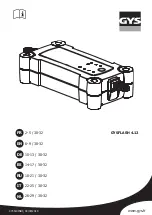
#
Do not lean over the battery.
#
Do not inhale battery gases.
#
Keep children away from the battery.
#
Immediately rinse battery acid o thor-
oughly with plenty of clean water and
seek medical attention immediately.
+
ENVIR
ENVIRONMENT
ONMENTAL NO
AL NOTE
TE Environmental
damage due to improper disposal of bat-
teries
Batteries contain pollutants. It is
illegal to dispose of them with the household
rubbish.
#
Dispose of batteries in an
environmentally responsible manner.
Take discharged batteries to a quali ed
specialist workshop or to a collection
point for used batteries.
Consult a quali ed specialist workshop to connect
the battery.
Observe the safety notes and protective measures
when handling batteries.
Risk of explosion
Fire, open ames and smoking are pro-
hibited when handling the battery.
Avoid creating sparks.
Electrolyte or battery acid is corrosive.
Avoid contact with the skin, eyes and
clothing. Wear suitable protective
clothing, in particular gloves, an apron
and a safety mask. Immediately rinse
electrolyte acid splashes o with clean
water. If necessary, seek medical
advice.
Wear eye protection.
Keep children at a safe distance.
Observe this Operator's Manual.
If you do not use the vehicle for a long period or
drive short distances regularly:
R
Connect the battery to a charger recommen-
ded for Freightliner Sprinter
R
Consult a quali ed specialist workshop to dis-
connect the battery
SSttar
arting assist
ting assistance and c
ance and char
harging t
ging the st
he start
arter bat-
er bat-
ttery
ery
#
Always use the jump-start connection in the
engine compartment for starting assistance
and when charging the battery.
*
NNOOTE
TE Damage to the battery from over-
voltage
When charging using a battery charger without
a maximum charging voltage, the battery or the
on-board electronics may be damaged.
#
Only use battery chargers with a maxi-
mum charging voltage of 14.8 V.
&
W
WARNING
ARNING Risk of explosion from hydrogen
gas igniting
There is a danger of hydrogen gas igniting
when charging the battery if there is a short
circuit or sparks start to form.
#
Make sure that the positive terminal of
the connected battery does not come
into contact with vehicle parts.
#
Never place metal objects or tools on a
battery.
#
The described order of the battery
clamps must be observed when connect-
ing and disconnecting the battery.
#
When giving starting assistance, always
make sure that you only connect battery
terminals with identical polarity.
#
During starting assistance, you must
observe the described order for connect-
ing and disconnecting the jumper cable.
224
224 Breakdown assistance
















































